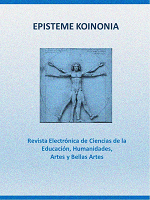M-learning: Estrategia para la promoción del aprendizaje electrónico móvil en instituciones de educación superior
DOI:
https://doi.org/10.35381/e.k.v3i5.684Keywords:
Computer assisted instruction, computer uses in education, educational technology, multimedia instruction.Abstract
The review article was focused on analyzing M-learning as a strategy for promoting mobile electronic learning in higher education institutions in Venezuela. The approach was created from an analytical perspective, developing a reflective process by the researchers and using a type of documentary research. It is evident that M-Learning by no means represents a substitute for traditional training since both can coexist perfectly depending on the needs; in addition, given the dizzying rise of new technologies, it can be said that students are well aware of the different computer media but educators (teachers, tutors and facilitators, among others) are the ones who handle cognitive technology, considering that its mission is to teach them how to optimize and use such mobile devices or instruments but for academic purposes; hence the challenge they must face.
Downloads
References
Aldana Zavala, J. J. (2019). La competencia epistemológica en el investigador social universitario venezolano. [Epistemological competence in the Venezuelan university social researcher]. Praxis, 15(1), 103-115. https://doi.org/10.21676/23897856.3091
Anderson, C., & Andara, Z. (2017). Entorno virtual de apoyo al aprendizaje para el curso peritaje laboral judicial ofertado por el departamento de postgrado de la UPTAG. [Virtual learning support environment for the judicial labor appraisal course offered by the UPTAG graduate department]. IUSTITIA SOCIALIS, 2(2), 45-61. Recuperado de https://n9.cl/st3j
Arias, F (2012). El proyecto de Investigación: Introducción a la investigación científica. [The Research project: Introduction to scientific research]. 6ta. Edición. Editorial Episteme.
Brazuelo Grund, F. & Gallego Gil, D. (2011). Mobile Learning: los dispositivos móviles como recurso educativo. [Mobile Learning: mobile devices as an educational resource]. Sevilla: Editorial MAD Eduforma. ISBN: 978-84- 676-5706-7
Cabal, C, Martínez, F y Molina, V. (2010). Sistemas de recomendación en el Comercio Electrónico y la E-educación. [Recommendation systems in Electronic Commerce and E-education]. Universidad libre de Bogotá. Criterio Libre ▪ Vol. 8 • No. 12 ▪ Bogotá, Colombia ▪ Enero - junio 2010 ▪ Pp. 161-182.
Cavaller, V. (2016). La tecnología cognitiva. [Cognitive technology]. Recuperado de https://n9.cl/6yegk
González, C (2014). Metodologías de aprendizajes colaborativos a través de las tecnologías. Redes sociales y los edublogs como herramientas de aprendizaje colaborativo. [Collaborative learning methodologies through technologies. Social networks and edublogs as collaborative learning tools]. Salamanca, España. Ediciones Universidad de Salamanca.
González Isasi, R., & Medina Morales, G. (2018). Uso de dispositivos móviles como herramientas para aprender Píxel-Bit. [Using mobile devices as tools to learn Pixel-Bit]. Revista de Medios y Educación, 0(52), 217-227. http://dx.doi.org/10.12795/pixelbit.2018.i52.15
Hernández, R, & Morales, M. (2010). Dispositivos móviles en educación. [Mobile devices in education]. Revista América Learning & Media. Recuperado de https://n9.cl/ae16e
Hernández, T (2010). M-learning como Estrategia de Diversificación en Ambientes Colaborativos. [M-learning as a Diversification Strategy in Collaborative Environments]. Universidad Dr. Rafael Belloso Chacín. Maracaibo. Venezuela.
Herrera, B. (2012). El móvil en la educación: Un nuevo paradigma. Ventajas y desventajas de su uso. [The mobile in education: A new paradigm. Advantages and disadvantages of its use]. Recuperado de https://n9.cl/hxw5m
I Vila, J. (2012). Aprendizaje social y personalizado: conectarse para aprender. Colección Educación Sociedad y Red. [Social and personalized learning: connect to learn. Collection Education Society and Network]. Recuperado de https://n9.cl/yste
Kinshuk, D (2009). Adaptive Mobile Learning Techonologies. Athabasca University. Recuperado de https://n9.cl/aulz
Marqués, P (2013). Claves para mejorar los aprendizajes integrando las tecnologías móviles en las clases” en Tecnología móvil e innovación en el aula. Nuevos retos y realidades educativas. [Keys to improve learning by integrating mobile technologies in classes ”in Mobile Technology and innovation in the classroom. New challenges and educational realities].Jornadas Internacionales (2013) Universidad de La Rioja. Recuperado de https://n9.cl/aulz
Martínez, R (2014). Sloodle: Conexión de entornos de aprendizajes. [Sloodle: Connecting learning environments]. Barcelona, España. Editorial UOC.
Mero Chávez, E., Fernando Pazmiño, M., & San Andrés, E. (2019). El flipped classroom como herramienta innovadora para el desarrollo del aprendizaje significativo. [The flipped classroom as an innovative tool for the development of meaningful learning]. Cienciamatria, 6(10), 646-661. https://doi.org/10.35381/cm.v6i10.281
Montero, L, & Gewerc, A. (2014). Educación, medios digitales y cultura de la participación. De las redes para el ocio de las redes sociales para la academia. Un estudio de caso. [Education, digital media and culture of participation. From networks for leisure to social networks for academia. A case study]. Barcelona España. Editorial UOC.
Palella, S y Martins, P. (2012). Metodología de la investigación cualitativa. [Qualitative research methodology]. 3era edición. FEDUPEL. Caracas-Venezuela.
Peche Cruz, H., & Giraldo Supo, V. (2019). El Aprendizaje Flip Learning centrado en el estudiante como generador de calidad educativa. [Student-centered Flip Learning as a generator of educational quality]. Revista Arbitrada Interdisciplinaria Koinonía, 4(8), 427-450. http://dx.doi.org/10.35381/r.k.v4i8.293
Perozo Martín, R., & Chirinos Martínez, A. (2019). Incidencias de la Tecnología web 2.0 en el contexto de la gobernanza y la gobernabilidad. [Incidences of Web 2.0 Technology in the context of governance and governability]. IUSTITIA SOCIALIS, 4(6), 90-116. http://dx.doi.org/10.35381/racji.v4i6.291
UNED (2018). Los recursos móviles en educación. De la pizarra tradicional a la tableta digital. [Mobile resources in education. From the traditional blackboard to the digital tablet]. Recuperado de https://n9.cl/287xv
UNESCO (2019). Aprendizaje móvil. [Mobile learning]. Recuperado de https://n9.cl/okij
Velazco Flórez, S. Y., Abuchar Porras, A., Castilla, I., & Rivera, K. (2017). E-Learning: Rompiendo fronteras. [E-Learning: Breaking boundaries]. Redes De Ingeniería, 91-100. https://doi.org/10.14483/2248762X.12480
Visa B, M. (2014) El EEES como marco de desarrollo de las nuevas herramientas docentes. [The EHEA as a framework for the development of new teaching tools]. Madrid, España. Editorial ACCI.
Xiao, B. & Benbasat, I. (2007). E-commerce product recommendation Agents: Use, Characteristics, and Impact, in: MIS Quaterly, Vol. 31, No. 1, pp. 137-209.
Published
How to Cite
Issue
Section
License
CC BY-NC-SA : Esta licencia permite a los reutilizadores distribuir, remezclar, adaptar y construir sobre el material en cualquier medio o formato solo con fines no comerciales, y solo siempre y cuando se dé la atribución al creador. Si remezcla, adapta o construye sobre el material, debe licenciar el material modificado bajo términos idénticos.
OAI-PMH URL: https://fundacionkoinonia.com.ve/ojs/index.php/epistemekoinonia/oai







